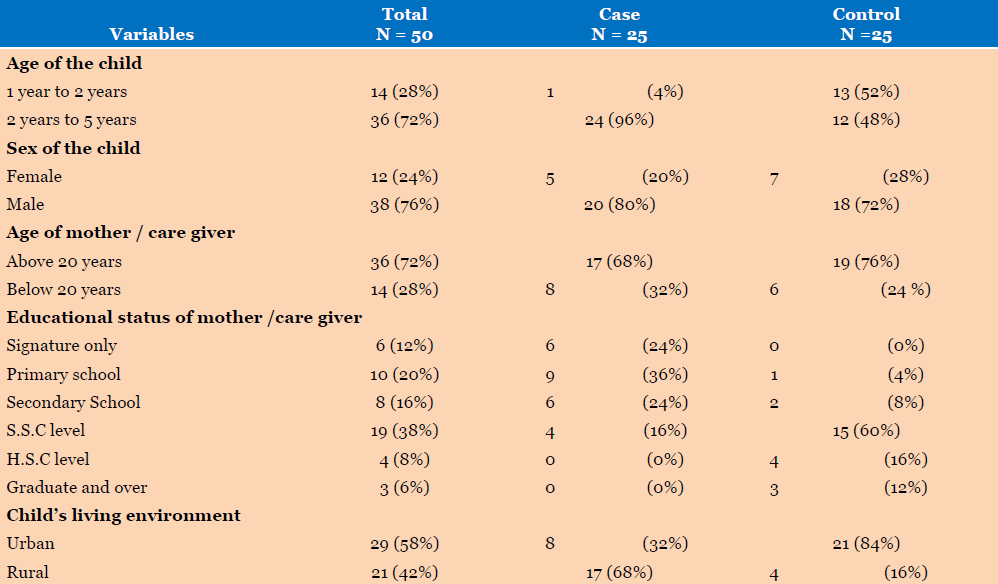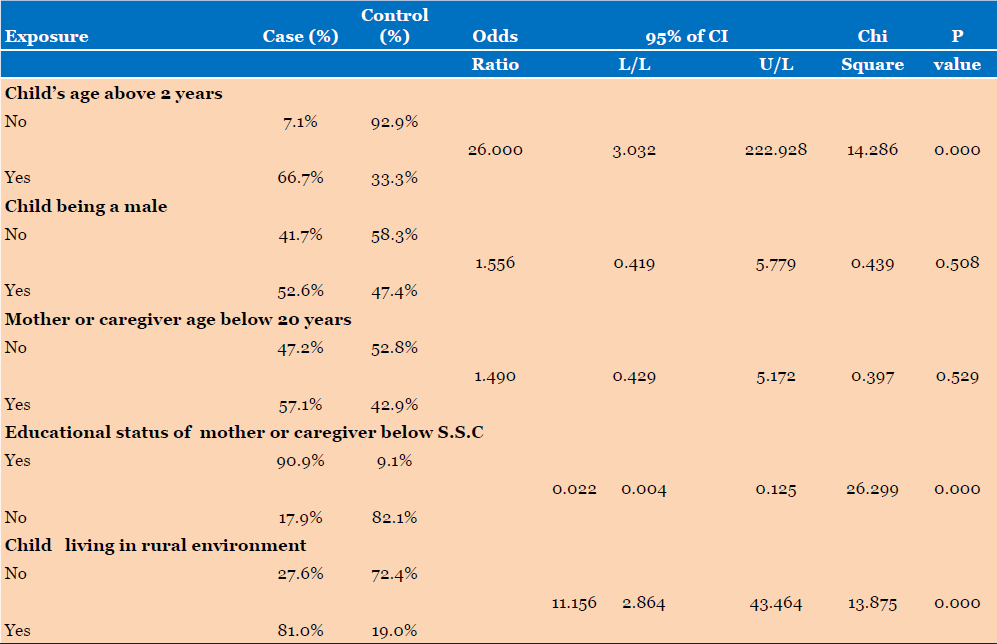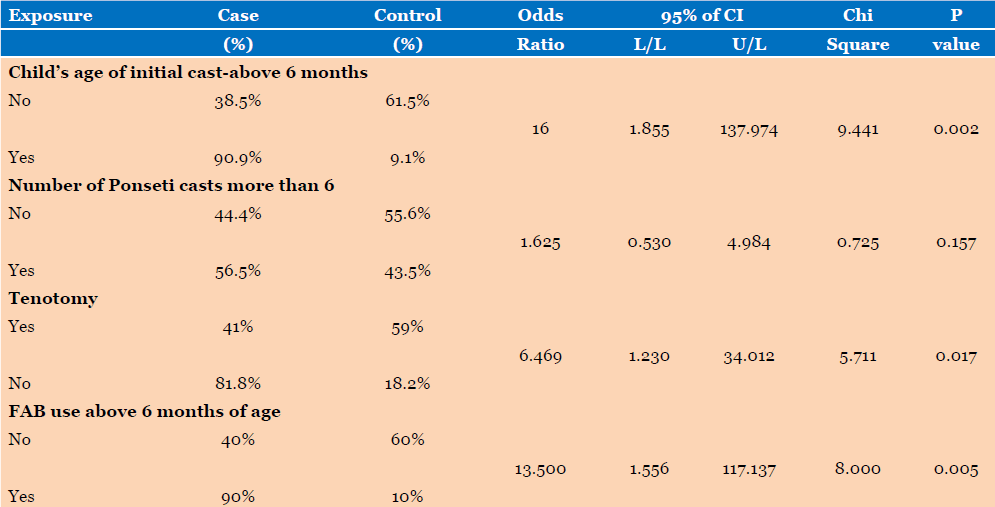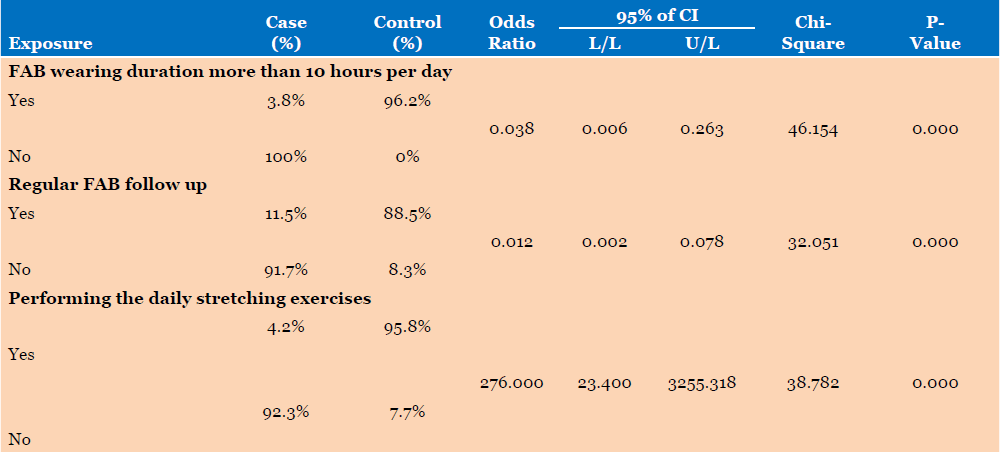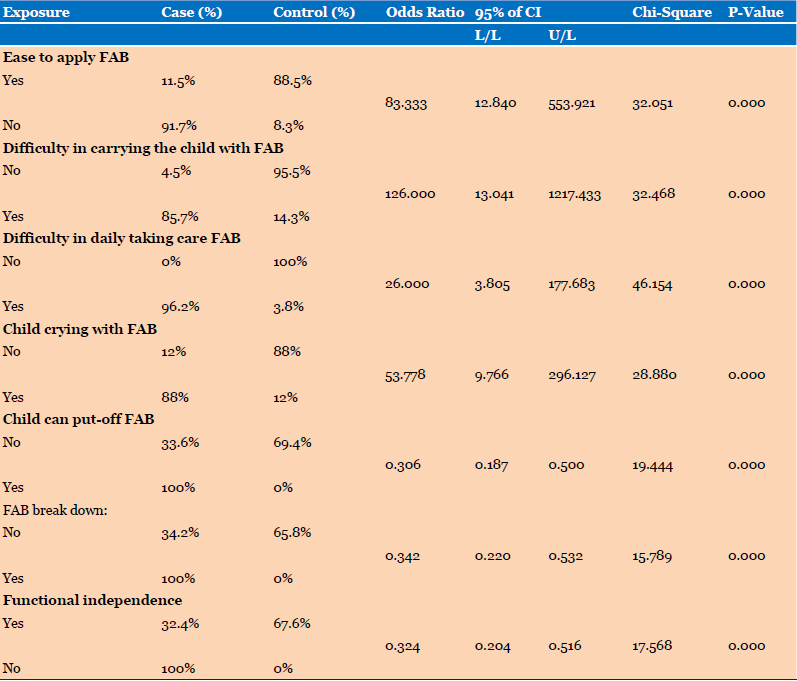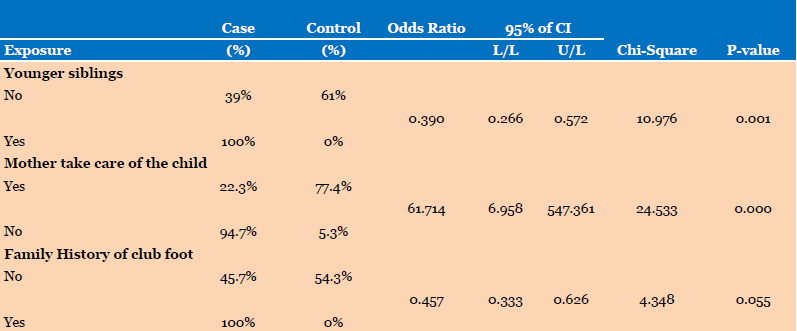 |
Original Article
Risk factors in the relapse of club foot treated by Ponseti method
1 Lecturer MSc in Rehabilitation Science Bangladesh Health Professions Institute, CRP Bangladesh
2 Former Associate Professor IHT
Address correspondence to:
S.J.M. Ummul Ambia
Lecturer MSc in Rehabilitation Science Bangladesh Health Professions Institute,
CRP Bangladesh
Message to Corresponding Author
Article ID: 100005P05SA2019
Access full text article on other devices

Access PDF of article on other devices

How to cite this article
Ambia SJMU, Ahmed K. Risk factors in the relapse of club foot treated by Ponseti method. Edorium J Pediatr 2019;3:100005P05SA2019.ABSTRACT
Aims: To examine the association between different factors and relapse club foot.
Methods: Case control observational study whereas the total participants was fifty those who complete clubfoot management with Ponseti method , from that twenty five was with case that means those who had relapse and another twenty five selected as control group those who had no history of relapsing.
Results: The result showed that mother or caregiver of the child did not comply with the use of Foot Abduction Brace (FAB). Noncompliance was the factor most related to the risk of relapse, with and odds ratio= 0.038 (P<0.01). Mother or care givers low educational level (less than secondary school certificate) also was a significant risk factor for relapse (odds ratio=0.022, p<0.01). In addition, the severity of the deformity, the age of the patient at the initiation of treatment, and previous treatment were not found to have a significant effect on the risk of relapse.
Conclusion: The study showed the most prominent risk factor of relapse clubfoot is noncompliance of foot abduction brace. The study also focused the issues behind the noncompliance of FAB. This identification might improve the compliance of the care giver with regard to the use of FAB and as a result improve outcome.
Keywords: Clubfoot, Ponseti method, Relapse
INTRODUCTION
Club foot is a congenital deformity [1]; described it as one of the most common visible structural imperfections of the foot at birth. The incidence rate of club foot is 1:900 live births that mean that every year 5000 new cases of club foot deformity are seen in Bangladesh [2]. The consequences of having a club foot for functioning in daily life are activity limitations, among others in the realms of squatting, walking, running, playing as well as limitations in a variety of jobs when adult (participation problems). Moreover, suffering from club foot have social (stigmatizing) and financial /economic consequences (missing the physical capacity that is needed for lots of jobs). Therefore, adequate treatment and life-long lasting good treatment results are imperative [3],[4].
The treatment of club foot deformity could be surgical and nonsurgical [5],[6]. The Ponseti method is basically a nonsurgical method mostly developed by understanding the anatomy of the tarsus bones of foot. This method simultaneously corrects four deformities (Cavus, Adductus, Varus and Equinus) of the club foot. The typical club foot management using the Ponseti method can be briefly described within four steps: manipulation, serial casting, tenotomy and bracing [7],[8],[9],[10].
The Pirani score is the commonly used system for classifying, evaluating, showing signs of relapsed and establishing the prognosis of club foot [1],[11].
Scher, (2005) [12] stated that relapsed club foot could be defined as the recurrence of the club foot deformity after or during continued treatment protocol. Usually relapsed club foot show the adductus and cavus deformity of the foot. The foot shows the supination due to the tibialis anterior muscle overpowering the weaker peroneal muscles, and the heel varus during walking. On examination, the movement restriction on subtalar and midtarsal joints will be observed. These losses of mobility are the signs of relapse. Correction of relapsed club foot again follows the same treatment protocol of the Ponseti method [1],[13].
Walk for Life one NGO of Bangladesh reported that about 5000 children with club foot are detected and treated by Ponseti method with in the year 2012 [2]. Clubfeet management by Ponseti method is found to be effective: 90% of the cases can be corrected [9],[10],[14],[15],[16],[17].
The Centre for the Rehabilitation of Paralyzed continue the treatment by the financial support of Wonder Work an NGO of USA. But if the children get relapse of the club foot, parents need to give full payment for further Ponseti management. So club foot relapse is a financial burden for the family. In Bangladesh club foot is successfully corrected by the Ponseti method but like in other countries a relapse is seen commonly. The Ponseti clinic of CRP Bangladesh has been expressing the same problem. There are some studies about club foot, but there has been no study about the risk factors for relapse in Bangladesh. So the purpose of this pilot study is to find out the risk factors related to relapse after Ponseti method in Bangladesh. The study has been conducted on the association between different factors and relapsed club foot. Outcomes might preliminary generate indications of what could be done to reduce the relapse rate in Bangladesh.
MATERIALS AND METHODS
This case-control study design (Figure 1) had been used for exploring the risk factors for club foot were relapse. Children with relapsed club foot were selected as case and children without relapsed club foot selected as controls. The control group will be included without matching with the group of cases, so it is an unmatched 1: 1 case control study. The children who were suitable with the inclusion criteria and willing to join the study were taken as a participant. The total number of subjects within each group (case and control group) was 25 (Figure 2).
RESULTS
Association of socio-demographical data with sub-groups
The educational status of the mother or care giver showed (Table 1, Table 2) a statistically significant result (The Chi2 probability value was 0.000 which is less than 0.01). This indicates that in the case group there are significantly more mothers or caregivers with low educational status compared to the control group. Likewise the child’s living environment in rural area showed the odds ratio is 11.156 (P<0.01) (Table 2) which is statistically significant. There were no significant association showed in between type of clubfoot and subgroups (Table 3).
Past medical history of clubfoot management by Ponseti method
Child’s age of initial casting below the age of six months showed the odd 16 in case and control group, whereas p(Table 4).
Use of foot abduction braces
The odds ratio is 0.038 with 95% CI ranging from 0.006 (LL) to 0.263 (UL). The probability value of Chi2 is 0.000 which is less than 0.01 (Table 5). The result is statistically significant. That means the null hypothesis (no difference between the sample’s two sub-groups) is rejected. This indicates that in the case group there are significantly less children that have been wearing the FAB during the recommended 10 hours per day as compared to the control group. Accordingly, missing follow up session and less stretching exercise showed statistically significant difference in case and control group.
Perceptions and attitude of care givers towards child with foot abduction braces
Highlighting the point’s applications of FAB at home and the easiness of using FAB showed the probability value of Chi2 is 0.000 which is less than 0.01 (Table 6). The result is statistically significant. The null hypothesis (no difference between the sample’s two sub-groups) is rejected. This indicates that in the case group the caregivers perceived more difficulties in applying the FAB at home as compared to the control group.
Other family oriented factors
Factors like family history of clubfoot, having younger children or absence of mother as a care giver has not showed a significant difference within case and control group (Table 7).
DISCUSSION
This study reported that the present position of the foot that showed relapse was on a moderate level (Pirani score – 2.5 to 4) a very few percentage showed mild relapsing that means parent might identify the relapse late. Similar finding was identified in the functional analysis part. The clinically diagnosed relapsing had been showed functional difficulty on squatting, walking and running. This issue when asked to the parents or caregiver they surprisingly not notice the difficulty on mild level. Therefore the ignorance of the alarming sign of relapsing also might be a risk factor. The study done by Haft et al., (2007) showed the same ignorance tendency by parents on a specific region. The important kind of information that came out from this study was about the functional independence level of the child: the physiotherapist observed that all the children within the case group showed limitations in squatting, walking and running but 48% of the care givers or mothers did not notice the functional limitations or difficulties of their child. This is also an important risk factor for relapse. The delayed identification of going to be relapse (gradually inward rotation of the corrected clubfoot) could be an upsetting sign of relapse clubfoot [18],[19],[20], [21],[22] [23],[24],[25].
The Ponseti method encourage the early intervention, it has been stated that the treatment can be started just after birth. The early starting time instantaneously influence the rest of the treatment protocol [1],[19]. This study reported an interesting association of initial age of casting and age of starting FAB use. The significant percentage showed that late start of casting and FAB use (above six months) in relapse group. Theoretically it might be due to after the age of six months the child gets, advance physical development (functional). Therefore, it might be quite difficult to cope with the casting and bracing procedure. Which could be increase the less use of brace and causes relapse. But there is no direct literature found on that issue. These findings of the study influence to do a future study on that aspect.
After recommendation of the foot abduction brace another very significant part of the treatment is the use of the brace as prescribed. Non-compliance is in the literature a manifest cause of relapse [5],[14],[25]. Ponseti’s treatment protocol describes FAB wearing duration at home and being present at regular follow up visits. This case control study found that most of the children with relapse had not been wearing the FAB at home during the prescribed time of minimal 10 hours a day. They also showed a history of less follow up visits, even less than three times. At the CRP Ponseti clinic had been added a improvisation aspect to the original Ponseti protocol of FAB wearing, that was performing daily stretching exercises at home to keep the foot and ankle joints mobile. The result showed that in the case group those stretching exercises were significantly more often not being performed at all. Henceforth, it could be predicted that less stretching exercise might have a relationship on relapse. The foot abduction brace (FAB) is used only after the club foot has been completely corrected by manipulation, serial casting, and possibly the Achilles tendon tenotomy. The recommendation of wearing the brace has been given to every single club foot affected child in Ponseti method. The FAB wearing duration started from 22 hours for the first three months of use then gradually the time schedule change (decrease). In the follow up session the standard time schedule for FAB is 10 to 12 hours per day. The follow up schedule has been given every three months for check the flexibility of the foot and give stretching exercise on ankle to maintain the flexibility [14]. This study showed a significant result on the issue of FAB wearing time, regular follow up and stretching exercises. Especially a majority percentage respondent of case group stated that use FAB less than 10 hours per day. They even take less than three time follow for FAB and 92.3% not interested to do stretching exercise at home.
The perception and attitude of the care giver had been conducted through a close end questioner very selectively. The issues concerning here the ease of appliance FAB by caregiver, carrying the child with FAB, taking care (feeding, sleeping) of the child with FAB, the child emotional status (crying too much) with FAB, the child capability of put off brace and the child breakdown the FAB during use. These entire factors showed a strongly significant association with relapse. There is no direct study about these issues, but several study focus noncompliance of FAB is the main risk factor for relapse 5, 25. This case-control study explicitly focused also on the complaints by care giver or mother with respect to the use of the foot abduction brace at home, to indicate the ‘reasons’ for the care giver (the underlying risk factors) for non-compliance to the therapy. Those ‘reasons’ were within the perceptions of the care giver - the way she looked at the child’s behavior and the way she experienced the FAB being a burden for herself -, and in her attitude: the way she handled the problems. The study found that significant more care givers of children with relapse expressed difficulties in applying the FAB/putting the FAB on, in carrying the child and in performing the daily care (feeding, dressing etc.). We found also significant more care givers of children with relapse who expressed care givers of children with relapse expressed that the child was crying too much wearing the FAB, that the child could put off the FAB by itself and that the child even had broken the FAB. All those factors were commonly found in the cases with relapse and very rarely in the control group. However, some of the studies had focused on the attendance of the child in the absence of the mother, and on the child’s comfort when using the FAB. In those studies very few children showed the capability to put off the FAB by won self and there were some cases with a breakdown of the FAB. But those numbers were very small in those studies and did not reach statistical significance [5],[14],[25].
A standardized information sheet explaining the Ponseti treatment method, the time commitment required, and the importance of compliance with the home management protocol was given to each family [26]. However, CRP Ponseti clinic currently have no method to assess how well the care giver or mother understood the information, and if they were motivated enough to be compliant with the bracing protocol and the follow-up visits to the CRP clinic. Especially follow-up visits from rural areas might be time consuming and a financial burden.
This study further examined other relevant family factors such as, younger siblings, mother being the care giver and a history of club foot in the family. These might be factors that are on the basis of the expressed ‘reasons’ for non-compliance. Culturally in Bangladesh the child daily caring will be done by their mother but surprisingly a significant larger number of children with relapse were cared for by other family members during their FAB using period. A significant number of the children with relapse while none of the children without relapse appeared to have a younger sibling. This might be related to the fact that the mother could not take daily care for the child with club foot. It is a tentative thought that a care giver who is not the mother herself might be less precise or less motivated in following the therapy instructions. There was only a small percentage (8%) with a history of club foot in the family. This might contribute to unfamiliarity of the care givers with the social and economic consequences of having a club foot or club foot relapse, and thus do not be a stimulant factor for adherence to treatment. The relevant other studies also supported the same perception.
CONCLUSION
The most prominent overall risk factor for club foot relapse is the noncompliance with the recommended use of the foot abduction brace: less than the minimum of 10 hours daily wearing time, less than 3 follow-up visits and not performing the daily stretching exercises as recommended by the CRP Ponseti team. This study also focused on the reasons behind the noncompliance. The care givers of children with relapse mentioned the very common problems with FAB were that: child was continously crying, care giver had difficulty in putting the FAB on, carrying the child with FAB and performing the daily care. Interesting was that these problems were mentioned less by care givers of the children without relapse.
REFERENCES
2.
Ford-Powell VA, Barker S, Khan MS, Evans AM, Deitz FR. The Bangladesh clubfoot project: The first 5000 feet. J Pediatr Orthop 2013;33(4):e40–4. [CrossRef]
[Pubmed]

4.
Lourenço AF, Morcuende JA. Correction of neglected idiopathic club foot by the Ponseti method. J Bone Joint Surg Br 2007;89(3):378–81. [CrossRef]
[Pubmed]

5.
Dobbs MB, Rudzki JR, Purcell DB, Walton T, Porter KR, Gurnett CA. Factors predictive of outcome after use of the Ponseti method for the treatment of idiopathic clubfeet. J Bone Joint Surg Am 2004;86-A(1):22–7.
[Pubmed]

6.
Bergerault F, Fournier J, Bonnard C. Idiopathic congenital clubfoot: Initial treatment. Orthopaedics & Traumatology: Surgery & Research 2013;99(1):S150–9. [CrossRef]

7.
Lehman WB, Mohaideen A, Madan S, et al. A method for the early evaluation of the Ponseti (Iowa) technique for the treatment of idiopathic clubfoot. J Pediatr Orthop B 2003;12(2):133–40.
[Pubmed]

8.
Changulani M, Garg NK, Rajagopal TS, et al. Treatment of idiopathic club foot using the Ponseti method Initial experience. J Bone Joint Surg Br 2006;88(10):1385–7. [CrossRef]
[Pubmed]

9.
Ponseti IV. Clubfoot management. J Pediatr Orthop 2000;20(6):699–700.
[Pubmed]

10.
Owen RM, Penny JN, Mayo A, Morcuende J, Lavy CB. A collaborative public health approach to clubfoot intervention in 10 low-income and middle-income countries: 2-year outcomes and lessons learnt. J Pediatr Orthop B 2012;21(4):361–5. [CrossRef]
[Pubmed]

11.
Dyer PJ, Davis, N. The role of the Pirani scoring system in the management of club foot by the Ponseti method. J Bone Joint Surg Br 2006;88(8):1082–4. [CrossRef]
[Pubmed]

12.
Scher DM. The Ponseti method for clubfoot correction. Operative Techniques in Orthopaedics 2005;15(4):345–9. [CrossRef]

13.
Bhaskar A, Patni P. Classification of relapse pattern in clubfoot treated with Ponseti technique. Indian J Orthop 2013;47(4):370–6. [CrossRef]
[Pubmed]

14.
Judd J. Congenital talipes equino varus – evidence for using the Ponseti method of treatment. Journal of Orthopaedic Nursing 2004;8(3):160–3. [CrossRef]

15.
Zionts LE, Sangiorgio SN, Ebramzadeh E, Morcuende JA. The current management of idiopathic clubfoot revisited: Results of a survey of the POSNA membership. J Pediatr Orthop 2012;32(5):515–20. [CrossRef]
[Pubmed]

16.
Jowett CR, Morcuende JA, Ramachandran M. Management of congenital talipes equinovarus using the Ponseti method: A systematic review. J Bone Joint Surg Br 2011;93(9):1160–4. [CrossRef]
[Pubmed]

17.
Colburn M, Williams M. Evaluation of the treatment of idiopathic clubfoot by using the Ponseti method. J Foot Ankle Surg 2003;42(5):259–67.
[Pubmed]

18.
Bor N, Coplan JA, Herzenberg JE. Ponseti treatment for idiopathic clubfoot: Minimum 5-year followup. Clin Orthop Relat Res 2009;467(5):1263–70. [CrossRef]
[Pubmed]

19.
Cooper DM, Dietz FR. Treatment of idiopathic clubfoot. A thirty-year follow-up note. J Bone Joint Surg Am 1995;77(10):1477–89.
[Pubmed]

20.
Alves C, Escalda C, Fernandes P, Tavares D, Neves MC. Ponseti method: Does age at the beginning of treatment make a difference? Clin Orthop Relat Res 2009;467(5):1271–7. [CrossRef]
[Pubmed]

21.
Dobbs MB, Morcuende JA, Gurnett CA, Ponseti IV. Treatment of idiopathic clubfoot: An historical review. Iowa orthop J 2000;20:59–64.
[Pubmed]

22.
Avilucea FR, Szalay EA, Bosch PP, Sweet KR, Schwend RM. Effect of cultural factors on outcome of Ponseti treatment of clubfeet in rural America. J Bone Joint Surg Am 2009;91(3):530–40. [CrossRef]
[Pubmed]

23.
Garg S, Porter K. Improved bracing compliance in children with clubfeet using a dynamic orthosis. J Child Orthop 2009;3(4):271–6. [CrossRef]
[Pubmed]

24.
Haft GF, Walker CG, Crawford HA. Early clubfoot recurrence after use of the Ponseti method in a New Zealand population. J Bone Joint Surg Am 2007;89(3):487–93. [CrossRef]
[Pubmed]

25.
Zionts LE, Zhao G, Hitchcock K, Maewal J, Ebramzadeh E. Has the rate of extensive surgery to treat idiopathic clubfoot declined in the United States? J Bone Joint Surg Am 2010;92(4):882–9. [CrossRef]
[Pubmed]

SUPPORTING INFORMATION
Author Contributions
S.J.M. Ummul Ambia - Substantial contributions to conception and design, Acquisition of data, Analysis of data, Interpretation of data, Drafting the article, Revising it critically for important intellectual content, Final approval of the version to be published
Kamal Ahmed - Substantial contributions to conception and design, Acquisition of data, Analysis of data, Interpretation of data, Drafting the article, Revising it critically for important intellectual content, Final approval of the version to be published
Guaranter of SubmissionThe corresponding author is the guarantor of submission.
Source of SupportNone
Consent StatementWritten informed consent was obtained from the patient for publication of this study.
Data AvailabilityAll relevant data are within the paper and its Supporting Information files.
Conflict of InterestAuthors declare no conflict of interest.
Copyright© 2019 S.J.M. Ummul Ambia et al. This article is distributed under the terms of Creative Commons Attribution License which permits unrestricted use, distribution and reproduction in any medium provided the original author(s) and original publisher are properly credited. Please see the copyright policy on the journal website for more information.




